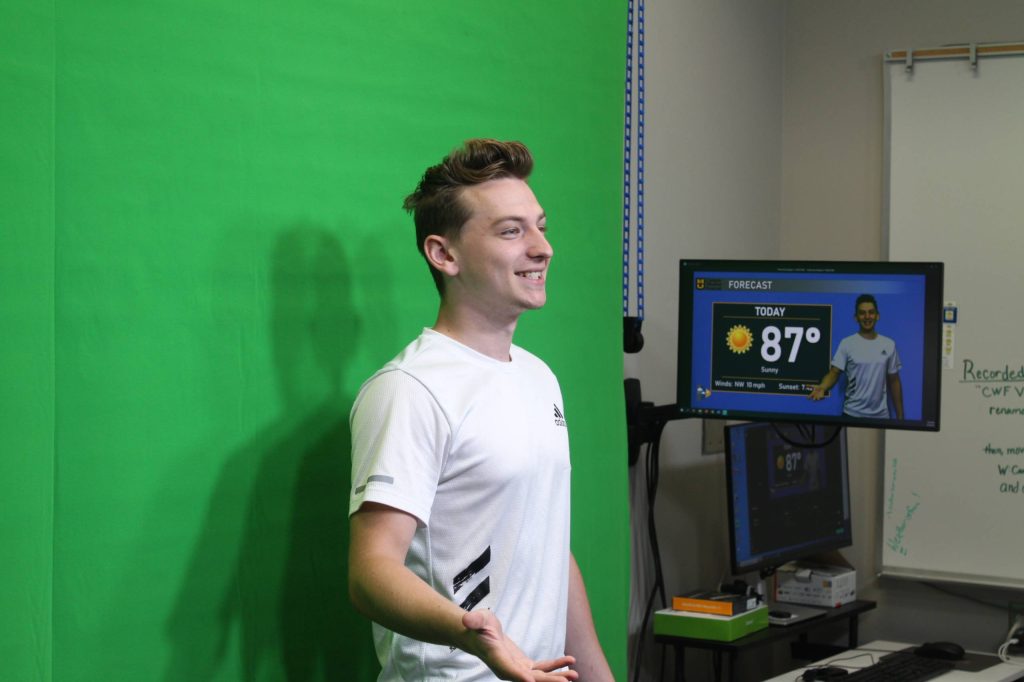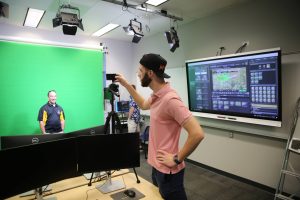
When the University of Missouri announced funding opportunities last year to enhance teaching and learning across campus, Eric Aldrich jumped at the chance, submitting a proposal to upgrade one of the School of Natural Resources’ meteorology laboratories.
Aldrich, an assistant teaching professor of atmospheric science, secured $100,000 – and immediately used the funds to update the Weather Analysis and Visualization (WAV) Lab in the Anheuser-Busch Natural Resources Building.
“This funding has provided a huge opportunity for our meteorology students,” Aldrich said. “The lab is now equipped with state-of-the-art technology that is going to help our students gain valuable hands-on experience and prepare them to jump right into a weather-related career.”
The lab includes new computer systems, with 12 double-monitor stations, that allow CAFNR students to run more weather models and forecasts, as well as conduct in-depth research. Students now have access to National Weather Service (NWS) software, too, along with a state-of-the-art television weather graphics computer that Aldrich said nearly 90 percent of television stations use. There is also a green screen where students can practice and produce their own weather forecasts. The lab is already being used for meteorology courses taught by Aldrich.

“With these additions, our students are set up for so much success,” Aldrich said. “They’re equipped with incredible tools and resources that should open doors for them to have success well beyond college.”
While the WAV Lab is set up to give students the opportunity to practice and perfect their forecasting, broadcasting and modeling skills, the goal is to have students develop and publish daily forecasts for faculty, staff and students throughout campus. The intention is to have those forecasts broadcasted on the various monitors in buildings throughout campus.
Aldrich said that at the moment around eight students are interested in producing those forecasts. They are doing so on a volunteer basis, as the work isn’t tied to a current course. Aldrich added that this type of project could eventually work its way into a class.
“We want to provide an important resource for our campus community,” Aldrich said. “Not only does it give our students in environmental sciences a chance to build their resumes, the information they provide is vital. The weather affects everyone, and we’re happy to share forecasts so that Mizzou faculty, staff and students are prepared for the day.”
Andrew Labit, a junior environmental sciences major, is one of the students who is already taking advantage of the WAV Lab. Labit began his collegiate career at MU with a desire to share timely weather forecasts with his fellow Tigers. Dubbed the Mizzou Weatherman, Labit sent weekly updates to nearly 800 students during his first two years at MU through a group text messaging app.
Now, Labit and several of his peers will share daily mid-Missouri weather forecasts with the MU student body through the new lab.
“This lab is really a dream come true,” Labit said. “It’s an incredible opportunity for us to work on each part of a weather broadcast, from developing our forecast to creating graphics and standing in front of the green screen to deliver the news. It’s really exciting.”
Labit, who is from the St. Louis area, developed a passion for the weather as a first grader, when he watched a major storm roll through his hometown.
“It was one of those classic storms, where it looks like it’s nighttime although it was the middle of the day,” Labit said. “I saw a giant bolt of lightning and was so enamored with the entire scene. Right then I knew I wanted to learn more about why storms happen and what they were capable of.”
Labit said after learning more about the variety of careers he could pursue, he settled on going for a degree that would help him become a broadcast meteorologist. He chose Mizzou because of its strong reputation related to his interests – plus the opportunity to work at KOMU-TV. Both of KOMU’s meteorologists are CAFNR graduates, and Labit has been interning with the station since January.
“The atmospheric science professors at MU are incredible,” Labit said. “It’s an amazing program that I knew would help me build a strong network.
“I just love to engage with people. I thought broadcast meteorology would allow me to not only pursue my passion for the weather, but also allow me to connect with others. I’ve been able to do that through KOMU and my group messaging experience, and putting together these campus weather forecasts will only expand my experience.”
Labit said he would eventually like to serve as a broadcast meteorologist in a major market. He’s also interested in doing work in North Carolina, which features plenty of severe weather similar to Missouri – but also gets tropical weather.
For now, Labit said he is relishing the opportunity to be an actual Mizzou weatherman.
“I’m excited to see what we are to build through the WAV Lab,” Labit said. “I always wanted to be the Mizzou weatherman, and the fact that I have the opportunity to be one is really something special. This is an incredible opportunity.”